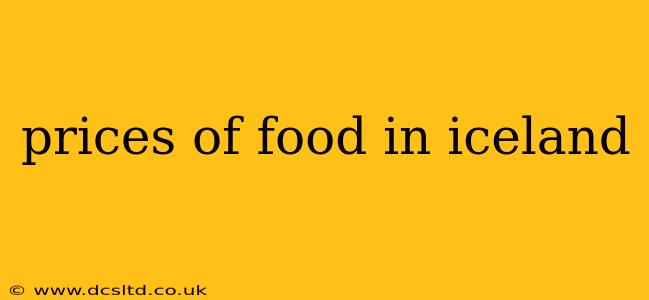Iceland, a land of fire and ice, also boasts a unique culinary scene. However, visitors often find themselves surprised by the cost of food. This comprehensive guide will delve into the prices of food in Iceland, covering everything from groceries to restaurant meals, helping you budget effectively for your trip.
What are the average food prices in Iceland?
Iceland's high cost of living significantly impacts food prices. While specifics fluctuate based on the season, location (Reykjavik is generally more expensive), and specific products, you can expect to pay considerably more than in many other European countries or North America. Groceries can easily cost double or even triple what you'd pay at home. A simple meal at a casual restaurant will often start around $30-40 USD per person, while upscale dining can be significantly pricier.
How much does it cost to eat out in Iceland?
The cost of eating out in Iceland varies wildly depending on the type of establishment.
-
Fast Food: A burger and fries at a fast-food restaurant might cost you around $20-30 USD.
-
Casual Dining: Expect to pay $30-50 USD per person for a casual meal at a bistro or café. This could include soup, sandwiches, or simple entrees.
-
Fine Dining: Fine dining in Iceland can be very expensive, easily reaching $100 USD per person or more, excluding drinks.
-
Street Food: While often more affordable than restaurants, street food in Iceland can still be relatively pricey. Expect to pay $15-25 USD for a substantial item like a hot dog or lobster soup.
Are groceries expensive in Iceland?
Yes, groceries in Iceland are notoriously expensive. This is due to a combination of factors, including import costs (many food products must be imported), high labor costs, and the relatively small domestic market.
-
Produce: Fruits and vegetables are often imported and thus expensive. Expect to pay significantly more than you're used to.
-
Dairy: Dairy products, while often locally sourced, are still relatively pricey compared to other countries.
-
Meat: Meat, especially lamb, is a staple in Icelandic cuisine, but can be quite costly.
-
Other staples: Bread, pasta, and other staples are also more expensive than in many other places.
To save money on groceries, consider shopping at Bonus, Kronan, or Nettó, which are some of the more affordable supermarket chains.
How can I save money on food in Iceland?
Budgeting for food in Iceland requires careful planning. Here are several strategies to help you save money:
-
Cook your own meals: This is the most effective way to reduce food costs. Stock up on groceries at the cheaper supermarkets and prepare your own meals.
-
Take advantage of happy hour deals: Some restaurants offer happy hour deals on food and drinks.
-
Look for lunch specials: Many restaurants offer more affordable lunch menus compared to their dinner options.
-
Pack snacks and drinks: Bringing your own snacks and water bottles can help you avoid impulse purchases and save money throughout the day.
-
Self-catering accommodation: Consider renting an apartment or vacation home with kitchen facilities, allowing you to prepare your meals.
What are some affordable Icelandic foods?
While many foods are expensive in Iceland, there are some more affordable options to consider:
-
Skyr: This Icelandic yogurt is relatively inexpensive and a great source of protein.
-
Hot dogs: While not exactly cheap, hot dogs are generally one of the more affordable readily-available meal options.
-
Fish: Depending on the season and location, fresh fish can be a more budget-friendly protein source than imported meat. Look for local catches at fish markets.
Is it cheaper to eat at the airport in Iceland?
No, eating at Keflavík International Airport (KEF) is generally considerably more expensive than eating at restaurants or cafes in Reykjavik or elsewhere in Iceland. It’s best to eat before heading to the airport or after arrival.
What is the best way to budget for food in Iceland?
Planning ahead is crucial. Research prices before you go, and create a realistic budget that takes into account both groceries and dining out. Consider allocating a larger portion of your budget to food than you might in other destinations. Remember to factor in the cost of alcohol, which can also be quite expensive in Iceland.
This guide aims to provide a realistic overview of food prices in Iceland. While expenses might be higher than expected, with careful planning and a little resourcefulness, you can enjoy delicious Icelandic food without breaking the bank.
